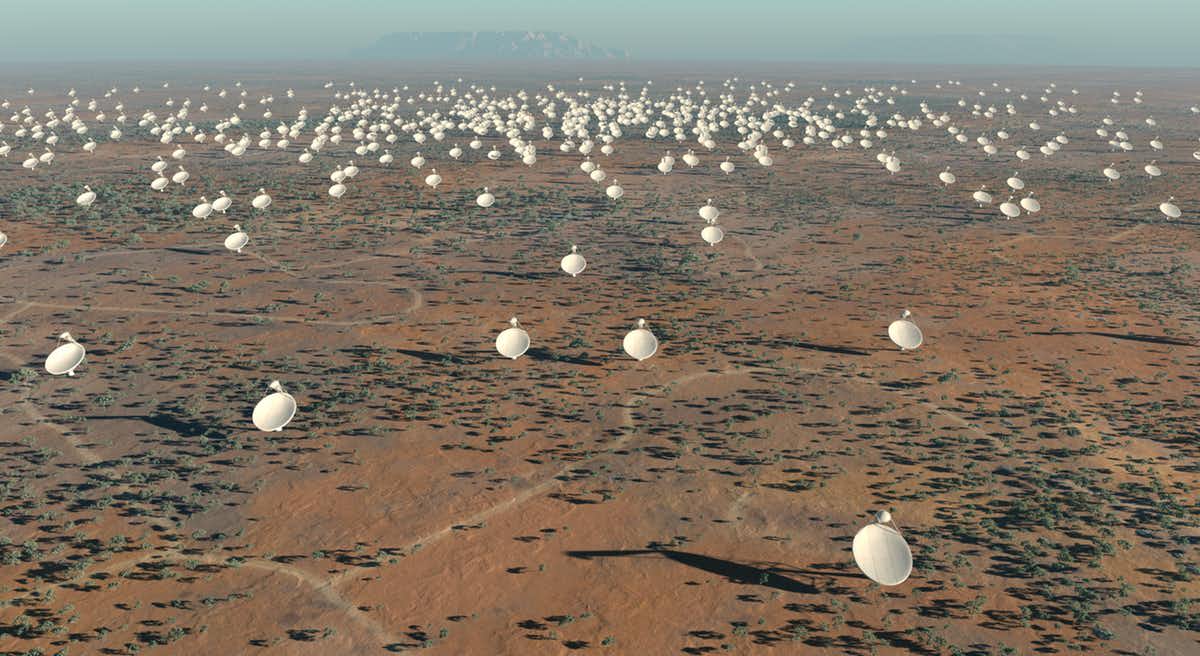Powerful new radio telescope could unmask the ancient universe — if satellites don't ruin the view

When completed, the Square Kilometer Array Observatory (SKAO) will be the world's most sensitive and most powerful radio telescope — that is, if SpaceX's Starlink satellites don't ruin its view.
Private companies have begun launching scores of "constellations" of communications satellites into low and medium Earth orbits, with the stated goal of blanketing the globe in high-speed internet access, real-time surface monitoring and more. Leading the charge is SpaceX, which has so far sent more than 4,600 of its Starlink satellites into space and has plans to have as many as 42,000 in orbit in the coming decade.
Other companies, like Amazon, plan to follow with constellations of their own. And while global high-speed internet access is undeniably good, these constellations do have repercussions for astronomy. Astronomers around the world have already warned that Starlink is beginning to spoil their ground-based observations and that the reflections from all the satellites will cause our nighttime sky to brighten across the world.
Related: Hubble Space Telescope images increasingly affected by Starlink satellite streaks
Radio astronomers are encountering similar difficulties caused by Starlink. First, the Netherlands-based LOFAR collaboration found evidence that Starlink transmissions were overwhelming the signals coming from some of their astronomical targets. And now, a team of astronomers helping to develop the SKAO have conducted preliminary tests and come to some troubling conclusions, which they revealed in a paper in the preprint database arXiv.
The researchers used a network of radio dishes called the Engineering Development Array 2 (EDA2), located in the deserts of Western Australia. The EDA2 is a test platform to help develop the full SKAO, which is expected to be completed in 2028. Combining sites in Western Australia and South Africa, the SKAO will be the world's premier radio telescope, with a highlighted mission of mapping the neutral hydrogen that inhabited our universe before the first stars ignited — a cosmological epoch known as the cosmic dawn.
The researchers could detect Starlink emissions with the EDA2, and these emissions were orders of magnitude brighter than the astronomical targets of the upcoming SKAO. Notably, they identified two sources of contamination. One was expected signals: the usual transmissions that the satellites send to each other and to the ground. But the other kind was unintentional: the radio signals generated by the individual satellites' own electronics. The EDA2 and the forthcoming SKAO are so supremely sensitive that they can detect these kinds of unintended emissions with ease.
The authors of the paper were diligent to note that several international governing bodies reserve some frequencies of radio transmissions solely for astronomical use and that the signals coming from the Starlink satellites are not within those protected bands. So SpaceX isn't violating any international agreements with either the intentional or unintentional radio emissions.
But the Starlink signals do overlap with the signals expected from the cosmic dawn, which will make studying that critical epoch much more challenging, especially because the unintentional emissions don't follow any sort of preplanned, announced or regular pattern — they're just noisy electronics. This makes it extremely difficult to filter out these signals from the data.
Related Stories:
—SpaceX and astronomers come to agreement on reducing Starlink astronomy impact
—World's biggest radio telescope could tease out secrets of dark matter, universe's 1st galaxies
—Megaconstellations could destroy astronomy, and there's no easy fix
On one hand, the SKAO and radio astronomers around the world will have to live with the new reality. Private companies are putting up tens of thousands of satellites, and they're not doing anything illegal. So radio astronomy will become more difficult as the radio environment around Earth becomes noisier.
On the other hand, the authors pointed out that the discovery of these kinds of contaminating signals offer a chance to create dialogues with the private companies or regulatory agencies. Astronomy as a science shouldn't exist in the margins on the good graces of private companies that are acting before lawmakers have time to assess and balance the needs of any affected communities. The time to act is now. Companies like SpaceX need to hear the voices of astronomers and astronomy enthusiasts about how these companies are affecting their ability to see and hear the night sky.
Blanketing the globe in high-speed internet access is a worthy goal, but it must be done with care and respect for the millennia-old human tradition of astronomy and with an eye toward balancing the needs of astronomers who wish to use the world's greatest observatories to unlock nature's most mysterious secrets.

